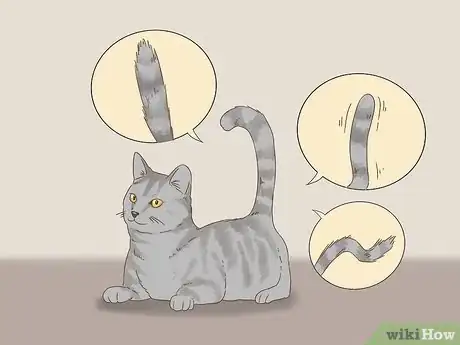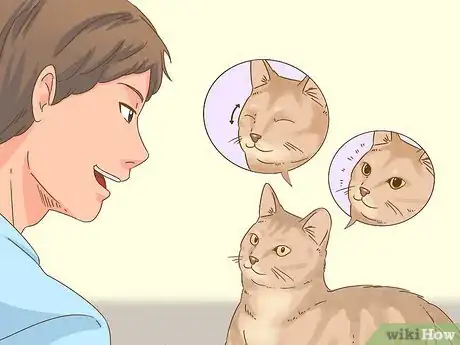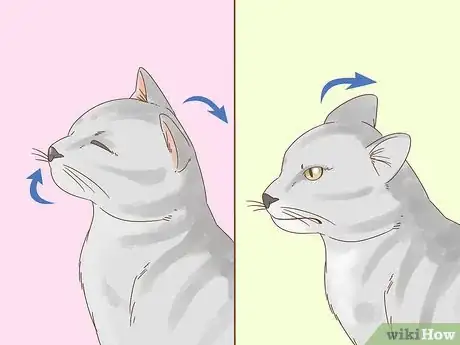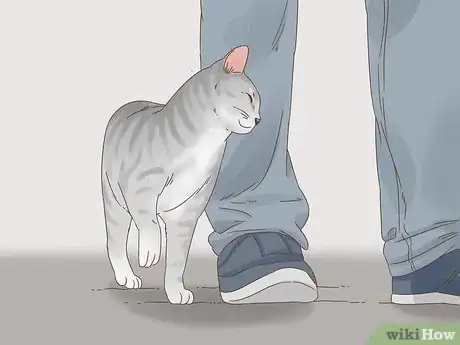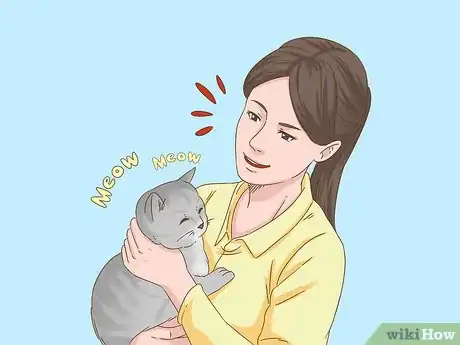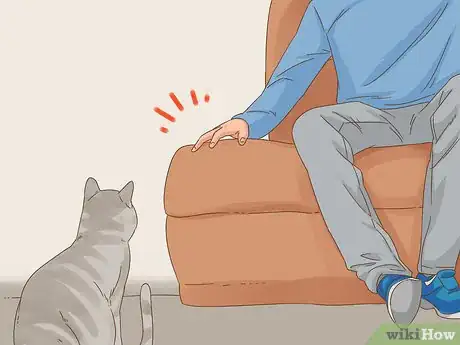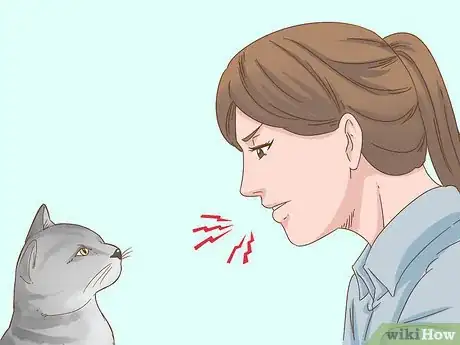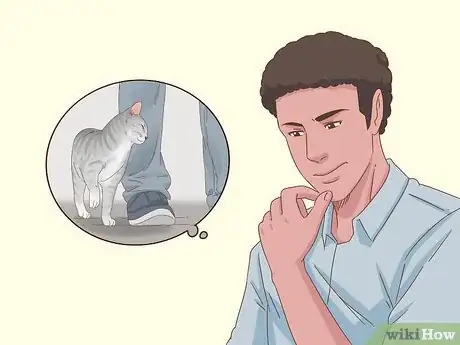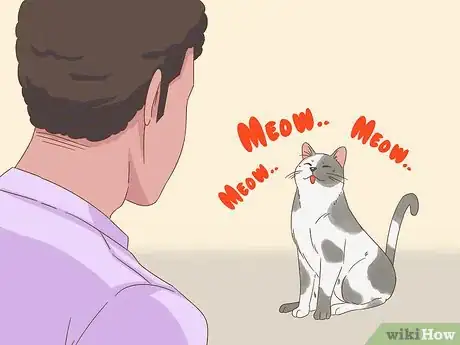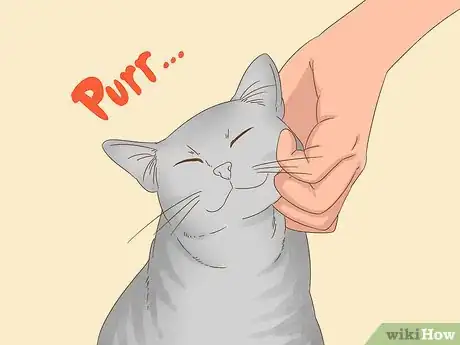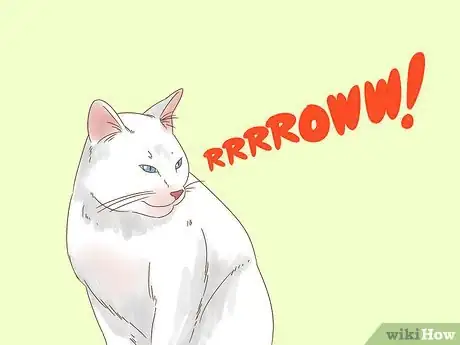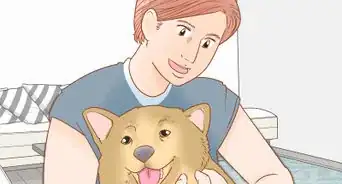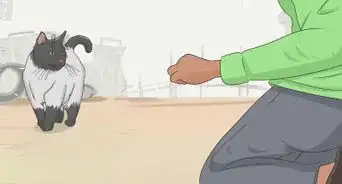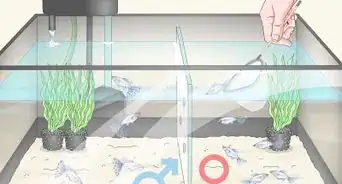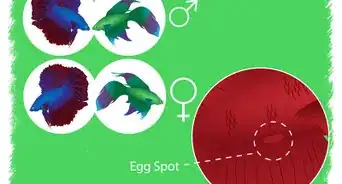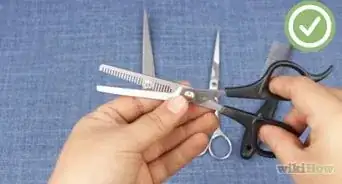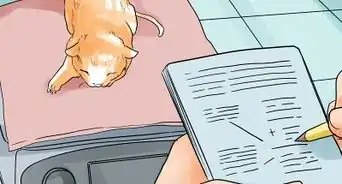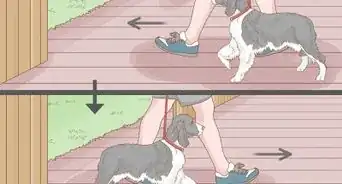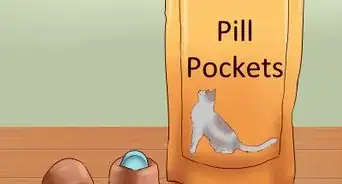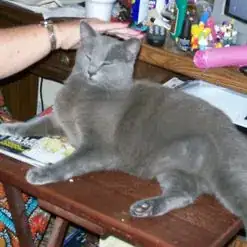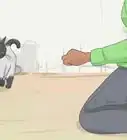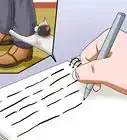This article was co-authored by Molly DeVoss. Molly DeVoss is a Certified Feline Training and Behavior Specialist (CFTBS), a Certified Cat Behavior Consultant (CCBC), a Fear Free Certified Trainer (FFCT), and the Founder of Cat Behavior Solutions. Molly specializes in using positive reinforcement to modify and prevent unwanted behaviors in cats and reduce cat shelter surrender. Molly has sat on the Dallas Animal Advisory committee since 2013 and was voted one of the Top 12 Extraordinary Cat Behaviorists of 2020 by Catpetclub.com. She is certified by both the Animal Behavior Institute and the International Association of Animal Behavior Consultants. She is also the host of the weekly podcast Cat Talk Radio.
wikiHow marks an article as reader-approved once it receives enough positive feedback. This article received 81 testimonials and 84% of readers who voted found it helpful, earning it our reader-approved status.
This article has been viewed 2,755,396 times.
Scientists have discovered that cats have developed an elaborate communication system with hundreds of vocalizations to tell humans what they want or need.[1] Developing an understanding of how your cat is communicating with you and how cats interpret human communication can help you cultivate a more nuanced relationship with your feline companion. [2]
Steps
Reading Cat Body Language
-
1Watch your cat’s tail. Like dogs, cats communicate with the positioning and movement of their tails.[3] Knowing the signals of tail position in conjunction with vocalizations can help you understand the needs and wants of your cat. Some common tail positions include:
- Tail straight up with a curl at the end: This indicates happiness.
- Tail twitching: Your cat is excited or anxious.
- Fur on tail sticking up or bushy: Your cat is excited, playful, or feels threatened.
- Tail vibrating: The cat is very excited and happy to see you.
- Tail fur sticks straight up while the tail curls in the shape of an N: This is a sign of extreme aggression and may be present during fighting or self-defense.
- Tail fur sticks straight up but the tail is held low: Your cat feels aggressive or frightened.
- Tail held low and tucked under the rear: Your cat feels frightened.[4]
- Tail around your leg: Your cat is greeting you.
-
2Look at your cat’s eyes. Gazing into your cat’s eyes can help you bond with them and read their feelings. Be aware, however, that direct staring without blinking may be interpreted as a position of aggression that makes your cat uncomfortable.
- If your cat’s pupils are dilated, they are feeling playful, excited, fearful or aggressive; use other behavior cues to determine which it is.[5]
- A cat staring into your eyes indicates that they trust you and are comfortable around you.
- A cat slowly blinking their eyes may be showing affection, indicating the cat is comfortable with whoever might be around them.
-
3Notice other body language. Since cats are more "fluent" than humans in body language, certain gestures will accompany vocalizations to reinforce their message.
- A cat lifting their nose and tilting their head back slightly is saying "I acknowledge you." Cats sitting in windows may greet you in this manner as you walk by.
- A cat may lay their ears back if they feel afraid, anxious, or playful.[6] This may also be seen when cautiously sniffing something they want to know more about.
- A cat who flicks their tongue out slightly and licks their lower lip is worried or apprehensive.
-
4Identify communicative behaviors. Some of a cat’s communication with you is based on how they behave around you. Certain behaviors have consistent meaning among most cats.[7]
- A cat rubbing against you is marking you as their property.
- A nose "kiss" is an affectionate feline gesture in which the cat taps their nose to you. This means that they like you and feel comfortable around you.
- A cat rubbing their head, flank and tail against a person or animal is showing an act of greeting.
- Playful head-butting is a show of friendliness and affection.
- Cats will sniff a person’s face to confirm their identity based on the familiarity of the smell.
- A cat will rhythmically knead with their paws, alternating between the right and left feet, as a sign of happiness, contentment, or playfulness. Kneading is an indication that your cat knows and trusts you.
- A cat licking you shows the ultimate sign of trust. Your cat may consider you to be a part of their family, like a mother cleaning her kittens.
- If your cat tries to eat your hair, they may be trying to "groom" you. This means your cat really loves and trusts you.
- Some cats will show they really love you by copying what you do. You can test this by playing dead on the floor. The cat may sniff or nudge you, then play dead too.
- If your cat bites you with little force, it is a warning for you to leave them alone.
Communicating with Your Cat
-
1Talk back to your cat. Cats are always learning how to communicate with us. The more you communicate with your cat, the faster they will learn.[8]
- Use a slightly raised tone of voice to indicate friendliness, and a lowered tone of voice to indicate displeasure.[9]
- Using repetition will help your cat learn to anticipate consistent activities. You may want to repeat a word such as sleep or bed each time you go to bed. Eventually, your cat will begin to associate the repetitive word sound with your actions and may even get to the bedroom before you.
-
2Use nonverbal communication cues. Cats can be trained to understand words, but they will instinctively understand nonverbal cues. Creating an environment with clear expectations and few surprises can help strengthen your initial bond with a new cat.
- If you blink slowly when making eye contact with your cat, they will usually respond by coming over to be stroked. This is seen as a very non-threatening gesture.
- Try not to stare directly into a cat’s eyes. It tells them that you're unfriendly or aggressive.[10]
- If your cat wants to go somewhere such as next to you on the couch, but they seem unsure, pat the space and use a soft, reassuring voice to invite them to join you.
- Be consistent in your intent and expression. A common blunder many pet owners make is to say "no" but pet the cat at the same time. This is very confusing to the cat. So for example, if you want your cat to go away, a firm "later" and a very gentle push, without showing affection, will let the cat know that their presence is not desired at this time. Most cats will try two to three times to invade a person's space, often from different directions. When saying "later", be patient.
- Never yell at or physically discipline a cat. This only frightens and angers the cat, and is counterproductive. Instead, to show displeasure, you can add a hard edge to your voice. The cat will pick up on that and sense unhappiness.[11]
-
3Deliver commands to your cat. Being consistent with the wording, tone, and other accompanying signals while giving your cat training commands will help both of you agree on and understand clear expectations.[12]
- Develop a commanding tone to use with your cat when they are doing something that you consider to be wrong. Use a voice that comes naturally to you and can be replicated easily, but that is also distinct from your everyday talking voice. If you use this voice sparingly but seriously, your cat will learn to associate the voice with the idea that they are displeasing you.
- Make a quick and sharp hiss or spit sound as a "no" command. This is similar to the sound made as a correction or warning in “cat language” and using it can communicate your intent more clearly to your cat.
- With patience, cats can be trained to respond to commands, much the same as for dogs. You can even teach your cat to shake your hand.
Listening to Your Cat
-
1Understand how and why cats communicate. Vocalizing is generally not your cat's preferred mode of communication. A cat's "first language" consists of a complex system of scent, facial expression, complex body language, and touch. Cats soon realize that we don't understand the non-verbal signals they send to each other, so they vocalize in an attempt to communicate in our language.[13] By observing which sounds elicit which actions from us, a cat is always learning how to make requests or demands.
-
2Observe meowing circumstances. If you watch what your cat is doing when they meow, you may be able to distinguish which meows are associated with which requests (or protests). While specific meows can vary from cat to cat, there are certain types of sounds that are usually associated with specific cat emotions, such as purring or hissing.[14]
- The short meow is used as a standard greeting and general acknowledgment.
- Multiple meows indicate excited greetings. You may notice a more enthusiastic greeting with increased meowing if you have been gone for a longer period of time than usual.
- A mid-pitched meow may indicate a plea for something like food or water.
- A longer, drawn-out "mrrroooow" is a more persistent demand for a need or want.
- A low-pitched "MRRRooooowww" indicates a complaint, displeasure, or preparation to fight.
- A loud, lower than mid-pitch "Meow" often signals more urgent begging for something such as food.
-
3Identify common non-meowing cat communication. While meowing is the sound that we most often associate with cat vocalization, cats make other common sounds as well.[15]
- Purring, a throaty vibrating sound, invites close contact or attention. While cats can purr for a variety of reasons, purring is most commonly associated with contentment.[16]
- Hissing is a cat’s clearest sign of aggression or self-defense. It indicates that your cat is very unhappy, feels threatened or frightened, or is fighting or preparing to fight.
-
4Notice other specialized vocalizations. While other types of vocalizations may be rarer than meowing, hissing, and purring, understanding them can help you interpret your cat’s communications more fully.[17]
- A high-pitched screech (RRRROWW!) often indicates anger, pain, or feeling fearful.
- A chattering sound can be a sign of excitement, anxiety, or frustration.
- A chirrup or trill, a cross between a meow and a purr with a rising inflection, is a friendly greeting sound, often used by a mother cat to call to her kittens
- A loud yelping or “reeeowwwing” sound may indicate sudden pain, such as when you accidentally step on your cat’s tail.
Expert Q&A
-
QuestionHow do you apologize to your cat?
 Pippa Elliott, MRCVSDr. Elliott, BVMS, MRCVS is a veterinarian with over 30 years of experience in veterinary surgery and companion animal practice. She graduated from the University of Glasgow in 1987 with a degree in veterinary medicine and surgery. She has worked at the same animal clinic in her hometown for over 20 years.
Pippa Elliott, MRCVSDr. Elliott, BVMS, MRCVS is a veterinarian with over 30 years of experience in veterinary surgery and companion animal practice. She graduated from the University of Glasgow in 1987 with a degree in veterinary medicine and surgery. She has worked at the same animal clinic in her hometown for over 20 years.
Veterinarian The best apology is never to repeat the action you want to apologize for. Cats live in the moment so, moving forward, speak quietly, pet them gently, and treat the cat with respect. They will accept this as an apology and rebuild the bond between you.
The best apology is never to repeat the action you want to apologize for. Cats live in the moment so, moving forward, speak quietly, pet them gently, and treat the cat with respect. They will accept this as an apology and rebuild the bond between you. -
QuestionMy cat keeps hitting the windows shutters. He doesn't stop no matter what. My mother tried yelling at him with all her strenght hundreds of times. Nothing seems to be working.
 Pippa Elliott, MRCVSDr. Elliott, BVMS, MRCVS is a veterinarian with over 30 years of experience in veterinary surgery and companion animal practice. She graduated from the University of Glasgow in 1987 with a degree in veterinary medicine and surgery. She has worked at the same animal clinic in her hometown for over 20 years.
Pippa Elliott, MRCVSDr. Elliott, BVMS, MRCVS is a veterinarian with over 30 years of experience in veterinary surgery and companion animal practice. She graduated from the University of Glasgow in 1987 with a degree in veterinary medicine and surgery. She has worked at the same animal clinic in her hometown for over 20 years.
Veterinarian Unfortunately, shouting at the cat can accidentally reward his bad behavior as he likes the attention. As an 'emergency' measure, you could purchase a can of compressed air that it triggered by movement. Position this on the window sill so the cat gets spritzed each time he attacks the shutters and this will soon stop him; however, also look into why he hits the shutters. Could he be bored? Make sure to play with him at least twice a day and really get him chasing round after toys.
Unfortunately, shouting at the cat can accidentally reward his bad behavior as he likes the attention. As an 'emergency' measure, you could purchase a can of compressed air that it triggered by movement. Position this on the window sill so the cat gets spritzed each time he attacks the shutters and this will soon stop him; however, also look into why he hits the shutters. Could he be bored? Make sure to play with him at least twice a day and really get him chasing round after toys. -
QuestionMy cat was meowing at nothing, after I called her name she stopped walked over behind the couch and started meowing again. Is she sick?
 Pippa Elliott, MRCVSDr. Elliott, BVMS, MRCVS is a veterinarian with over 30 years of experience in veterinary surgery and companion animal practice. She graduated from the University of Glasgow in 1987 with a degree in veterinary medicine and surgery. She has worked at the same animal clinic in her hometown for over 20 years.
Pippa Elliott, MRCVSDr. Elliott, BVMS, MRCVS is a veterinarian with over 30 years of experience in veterinary surgery and companion animal practice. She graduated from the University of Glasgow in 1987 with a degree in veterinary medicine and surgery. She has worked at the same animal clinic in her hometown for over 20 years.
Veterinarian Cats can become vocal for lots of reasons, some of which are behavioral and some health related. Only your vet can truly tell if the cat is sick, but be alert for changes in her eating and drinking habits, litter box offerings, and activity levels. If these are altered then get her checked. Also older cats can become more vocal if they have gone deaf, so you might want to test her hearing (although she did come when you called.) Alternatively, some cats meow at nothing because it got your attention last time, so be sure she gets lots of fuss and isn't bored.
Cats can become vocal for lots of reasons, some of which are behavioral and some health related. Only your vet can truly tell if the cat is sick, but be alert for changes in her eating and drinking habits, litter box offerings, and activity levels. If these are altered then get her checked. Also older cats can become more vocal if they have gone deaf, so you might want to test her hearing (although she did come when you called.) Alternatively, some cats meow at nothing because it got your attention last time, so be sure she gets lots of fuss and isn't bored.
Warnings
- All cats should be spayed or neutered as soon as they are old enough to avoid behavior problems and unwanted kittens. Male cats, in particular, should be altered before they are sexually mature to prevent spraying from becoming ingrained.⧼thumbs_response⧽
- Urinating, spraying, and depositing feces in a prominent spot are often a cat's attempt to mark territory that they feel is being threatened by another cat or pet. It may also be an indication of a urinary tract, bladder infection, or other serious health issues. If this is a problem, the cat may need to be treated, or separated from other cats. Consult your veterinarian.⧼thumbs_response⧽
- Hold your cat carefully, not tightly when you pick them up. Holding too tightly can scare or hurt your cat, and they may attack in self-defense.⧼thumbs_response⧽
References
- ↑ http://www.news.cornell.edu/releases/May02/cat_talk.hrs.html
- ↑ http://www.messybeast.com/cat_talk.htm
- ↑ http://www.humanesociety.org/animals/cats/tips/cat_communication.html
- ↑ Molly DeVoss. Certified Feline Training and Behavior Specialist & Certified Cat Behavior Consultant. Expert Interview. 28 June 2021.
- ↑ http://pets.webmd.com/cats/features/cat-body-language?page=2
- ↑ Molly DeVoss. Certified Feline Training and Behavior Specialist & Certified Cat Behavior Consultant. Expert Interview. 28 June 2021.
- ↑ http://www.humanesociety.org/animals/cats/tips/cat_communication.html
- ↑ http://www.messybeast.com/cat_talk.htm
- ↑ http://www.messybeast.com/cat_talk.htm
- ↑ http://pets.webmd.com/cats/features/cat-body-language?page=2
- ↑ https://www.aspca.org/pet-care/virtual-pet-behaviorist/cat-behavior/training-your-cat
- ↑ https://www.aspca.org/pet-care/virtual-pet-behaviorist/cat-behavior/training-your-cat
- ↑ Molly DeVoss. Certified Feline Training and Behavior Specialist & Certified Cat Behavior Consultant. Expert Interview. 28 June 2021.
- ↑ Molly DeVoss. Certified Feline Training and Behavior Specialist & Certified Cat Behavior Consultant. Expert Interview. 28 June 2021.
- ↑ http://www.humanesociety.org/animals/cats/tips/cat_communication.html
- ↑ Molly DeVoss. Certified Feline Training and Behavior Specialist & Certified Cat Behavior Consultant. Expert Interview. 28 June 2021.
- ↑ http://www.humanesociety.org/animals/cats/tips/cat_communication.html
- ↑ http://www.messybeast.com/cat_talk.htm
About this article
To communicate with your cat, use a raised tone of voice to show you're happy and a lowered tone of voice to indicate that you're not pleased. You can also try blinking slowly when making eye contact with your cat as a sign of affection. However, be careful not to stare into your cat's eyes for too long since that can be perceived as a threat. If you want to learn what your cat's different "meows" mean, pay attention to whether it seems happy, scared, or hungry when it meows. Eventually, you'll be able to tell how your cat is feeling based on the noises it's making! To learn how to read your cat's body language, keep reading!
